The London Orthotic Consultancy has been providing non-surgical pectus treatment for several years, achieving positive results in our patients.
We treat pectus carinatum with the Dynamic Chest Compressor brace and a daily exercise routine. The brace applies pressure to the protruding area of the chest, helping it become less pronounced and resume a more normalised shape.
In order to achieve positive correction, patient compliance is incredibly important; both in wearing the brace daily for the prescribed time period and completing exercises set by one of LOC's clinicians.
Outcomes can vary greatly from patient to patient, and are influenced by a number of factors such as age, severity and flexibility of chest to name a few, but we generally expect to see positive results within a year.
We are proud to be the pioneers of this treatment in the UK and are pleased to share some patient successes for those who have undergone treatment with us. These include patient chest scans and photos which we have kindly been given permission to share.
Treatment type: Carinatum Brace, Rib Flaring Brace
As is the case with many pectus patients, patient A came to see us as a teenager at the age of 16. His family began noticing drastic lower rib flaring and his chest becoming pushed out (pectus carinatum) over a period of six months.
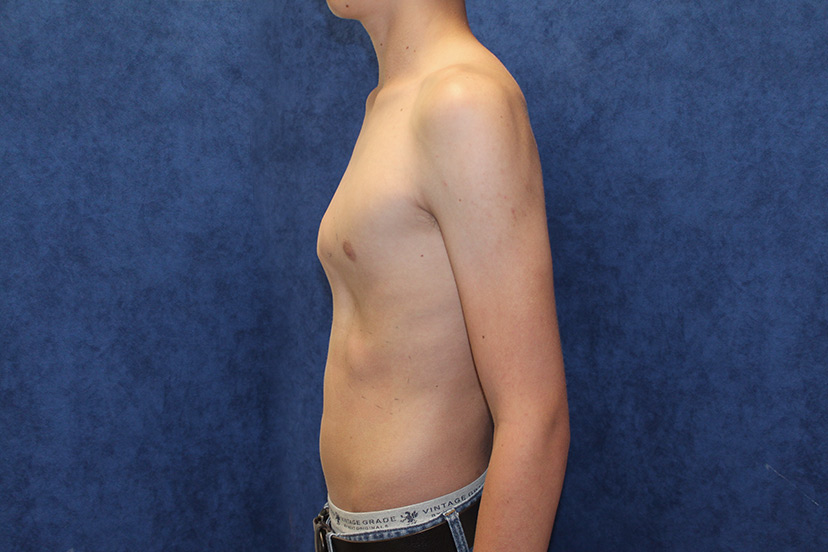
Above: Before bracing treatment, the sternum is 'pushed out'
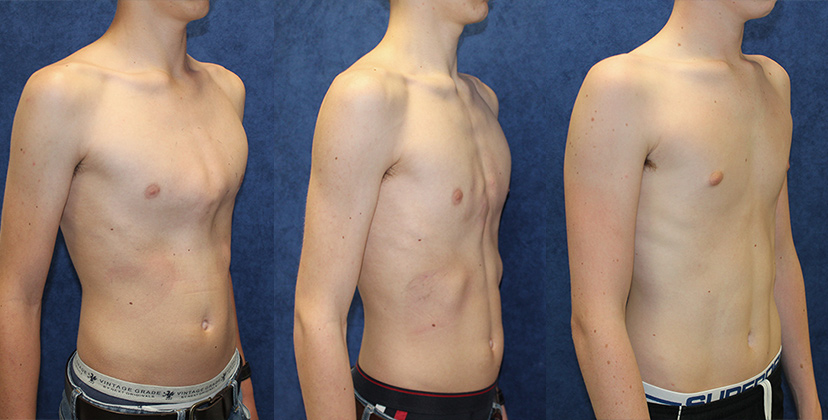
Above; Before, during and after treatment
They subsequently decided to come in and see us at LOC for a free, no-obligation appointment, where it was determined that his carinatum was inferior and lateral, requiring treatment.
It was agreed that to achieve the best results, two dynamic chest compressors would be used; one to correct the carinatum area by applying downward pressure, the other to reduce the rib flaring.
These braces were used in conjunction with daily exercises given by our personal trainer – patient A complied perfectly and as a result, started seeing improvements quickly.
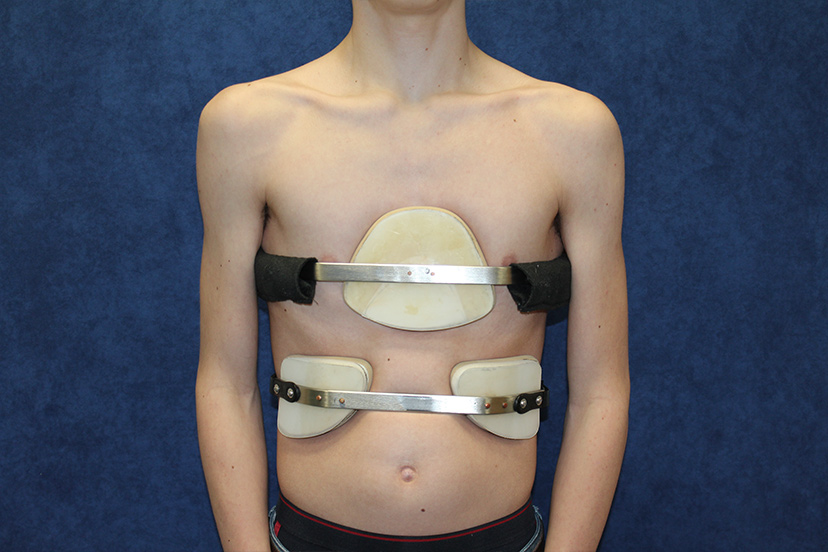
Treatment type: Carinatum Brace
Patient B first came into see us at the age of 14 with an evident case of pectus carinatum, with a protruding chest and rib flaring. Previously advised by doctors that he would need surgical treatment, he was delighted to be told that he would be a perfect candidate for our non-surgical treatment programme.
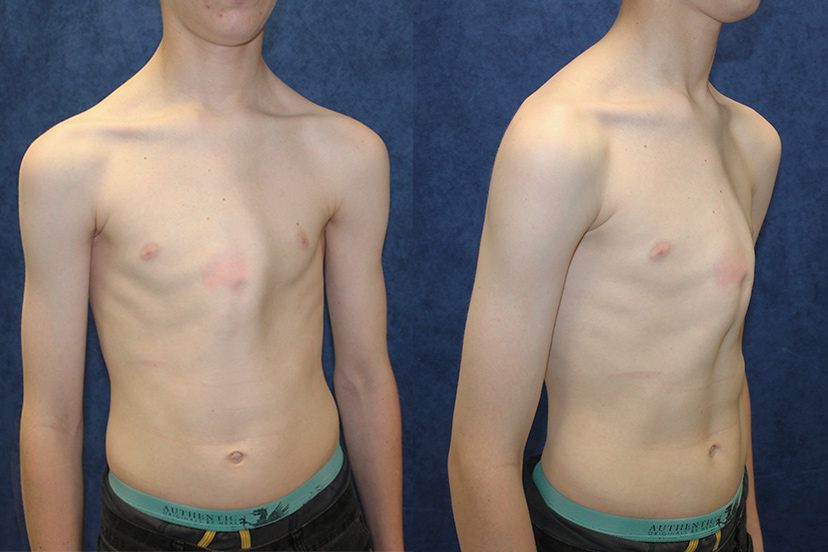
Above: Before treatment
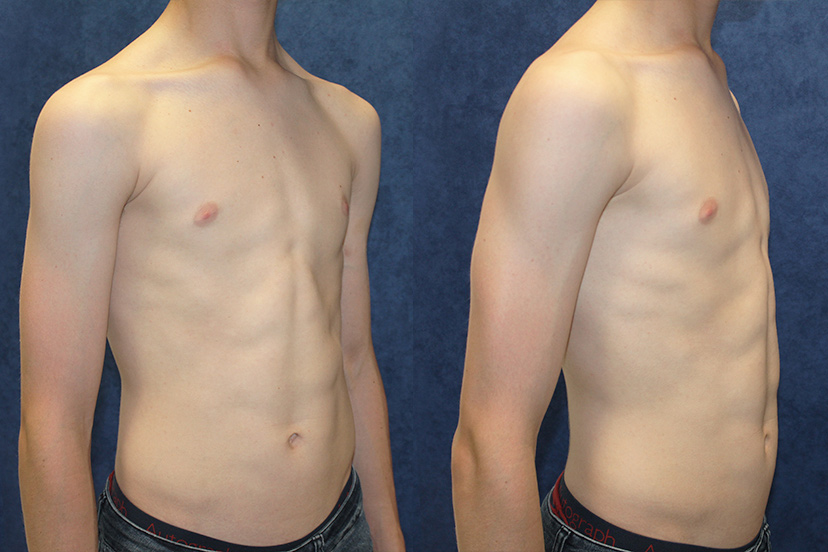
Above: After treatment
During teenage years the chest wall is more flexible and malleable, where the body has not yet reached skeletal maturity. Starting treatment at a young age before or during puberty means that the dynamic chest compressor is able to work most effectively.
For some teenagers with chest deformities, the cosmetic aspect of the condition can cause the most distress, causing them to be self-conscious – and our patient was highly motivated to achieve results.
After just six months he began to show significant improvement and his chest appeared flattened. However, to maintain the progress achieved, he wore the brace for a further nine months at night time only, to ensure he sustained the progress throughout his growth spurts.
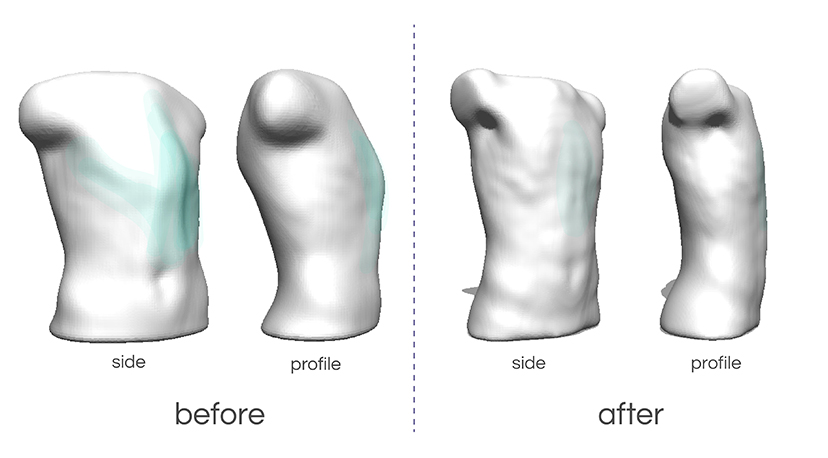
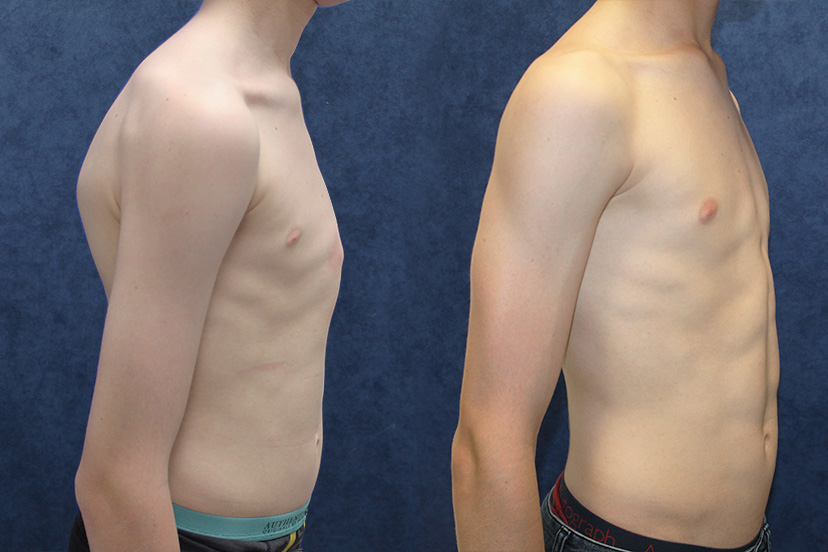
Above: Before and after pectus carinatum treatment
Patient B’s chest now appears completely flattened and we are extremely pleased to have helped him achieve such great results. You can read his full story in our blog post 'Chest bracing works wonders for teenage pectus carinatum patient'.
Treatment type: Carinatum Brace
Patient C came in for his first consultation at the age of 16 with pectus carinatum inferior. Although his pectus carinatum was not causing him health issues, it was making him feel self-conscious – and so it was decided that he would begin our LOCpectus treatment programme.
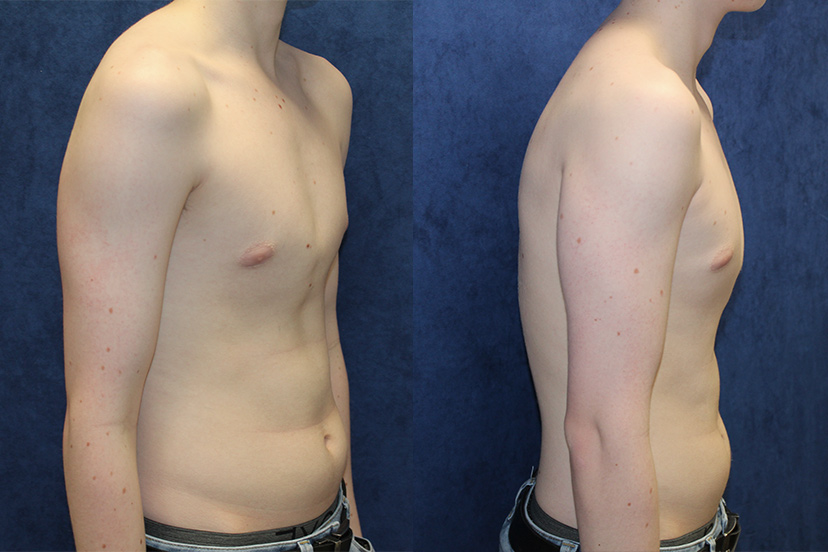
Above: Before treatment
Patient C’s bespoke programme consisted of wearing a brace full-time for 19 months, alongside personal training sessions. It is worth noting that for successful results in treating pectus, patient compliance is very important, this means wearing the brace for the prescribed times and completing the exercises.
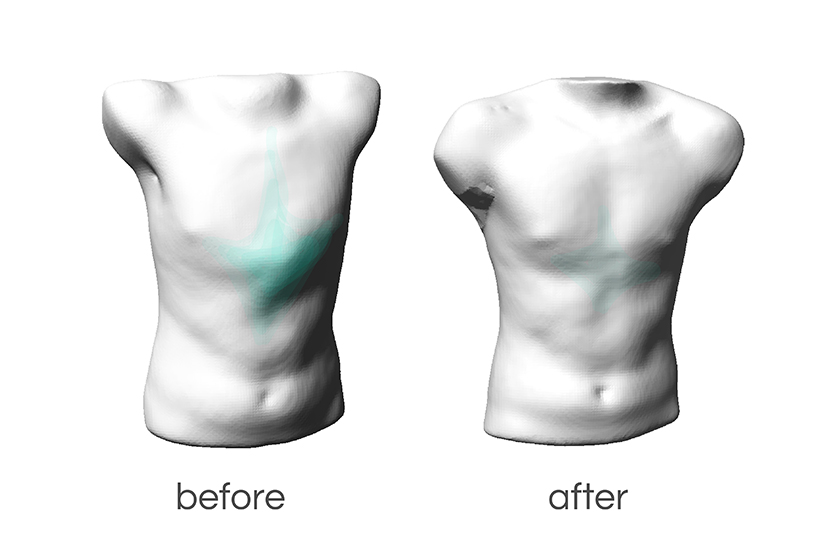
Above: Before and after scan comparison
Patient C made brilliant progress during his 19 months of treatment – achieving a completely flat chest. His last scan was taken three months after he stopped wearing the brace and showed that he had maintained all the great progress made.
Treatment type: Carinatum Brace
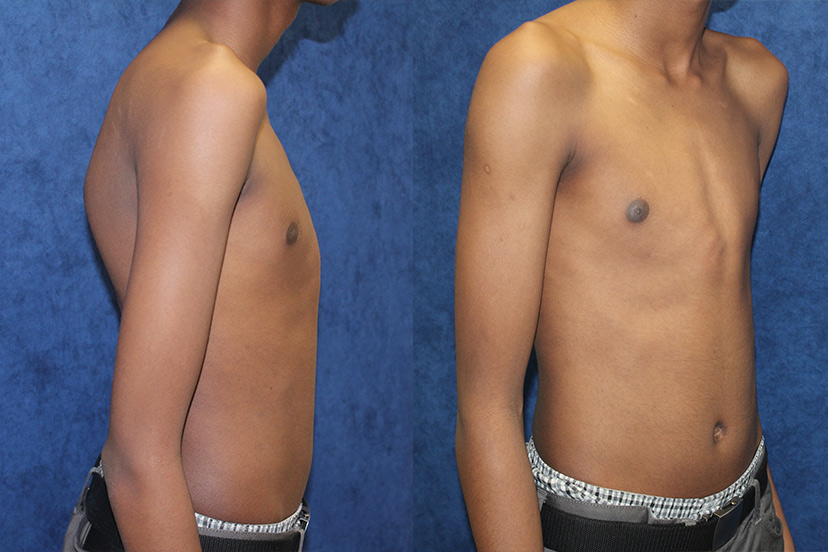
Above: Before treatment
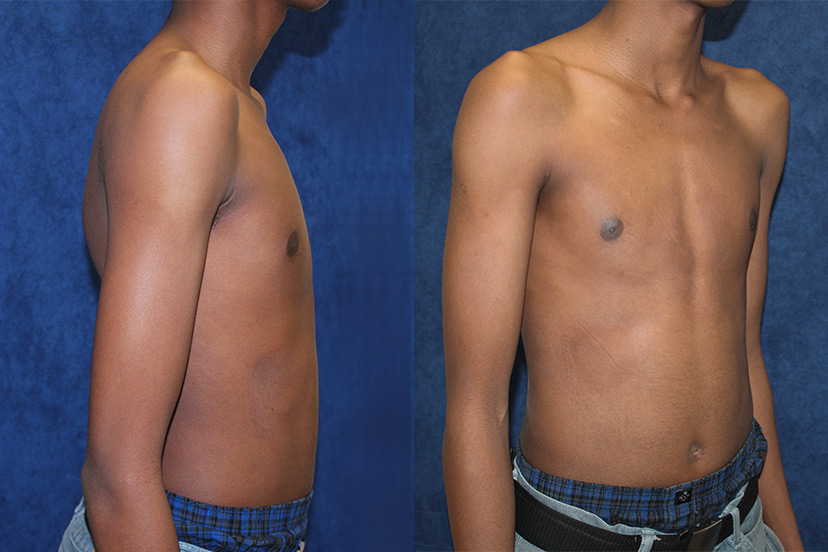
Above: After treatment
Patient D came into see us with his family at the age of 16 with severe pectus carinatum. As his sternum protruded considerably, he was keen to begin treatment as soon as possible. Pectus clinician Sam Walmsley decided that he would wear two braces – the dynamic chest compressor 1 for the chest protrusion and the dynamic chest compressor 2 for his rib flaring.
After just 11 months Patient D achieved a total correction of his chest shape, with which he was very happy. His treatment programme is another great example of how pectus carinatum can be successfully treated using the dynamic chest compressor, and without surgery.
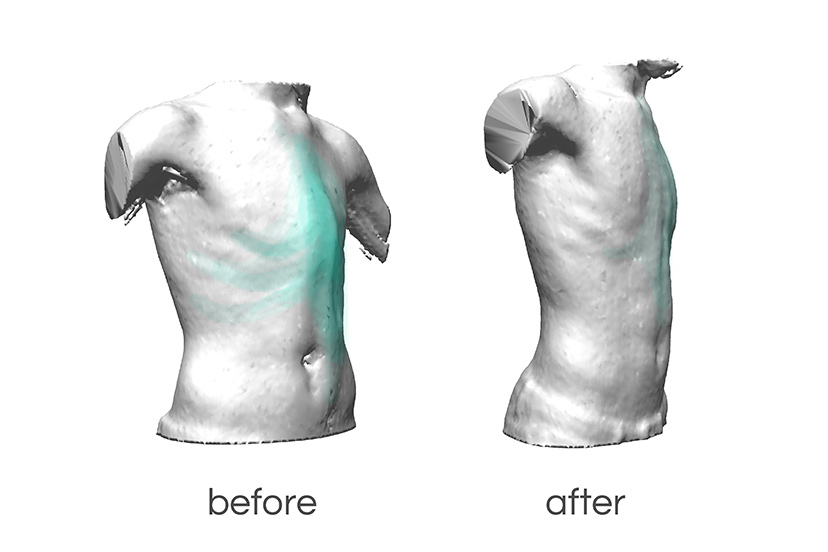
Above: Before and after scan comparison
If you or your child’s chest protrudes significantly, and you think you might have pectus carinatum, LOC offers a free, no-obligation first consultation.
During this assessment, LOC clinicians will measure your chest and examine your posture to determine whether treatment is necessary. Visit our pectus carinatum page for everything you need to know about the condition or contact us to book your free consultation today.
This depends on several factors; the position of the chest wall deformity, its severity, the flexibility of the chest, the kind of results wanting to be achieved and the age of the person undergoing treatment for pectus excavatum or pectus carinatum.
Early adolescence (roughly between the ages of 12-16 years old) – is an optimum age to start treatment, given that the chest is still maturing, and flexible, permanent correction is more easily achievable. Once bracing treatment is complete and a patient has stopped growing, the deformity will not return. For younger pectus patients, conservative bracing is used to keep a deformity from worsening and can help them to avoid surgery in later life.
For older pectus patients (between the ages of 20 to 30) results can be harder to achieve, as the costal cartilage hardens into the bone as a person matures. Over the years we have successfully treated many adults for both pectus excavatum and pectus carinatum and active adults with flexible chests can expect good results.
Again, this hugely depends on what a patient wants to achieve from treatment; whether that’s avoidance of surgery, improvement in the appearance of the chest shape, reduction in rib flaring etc. All these goals are taken into consideration during your first consultation. While there are no serious health risks of having pectus carinatum or excavatum – beyond the cosmetic – for many patients and parents, treatment outcomes involve improving confidence and self-esteem. During our 2018 Pectus Patient Survey, 92% of pectus carinatum patients surveyed said that treatment had a ‘major improvement’ or ‘an improvement’ on their social life.
You can read the results of our 2018 Pectus Patient Survey and quality of life questionnaire here.
Regular reviews are part of the treatment programme, preferably in clinic with one of our specialist orthotists, or via Skype consultations.
The number of appointments needed will vary from patient to patient but as a general rule, younger pectus patients who are growing at a faster rate will need to be seen more regularly for check-up appointments. This is to ensure that the brace fits well and is guiding the chest into the correct position as growth spurts occur. For other patients, this can be scaled back according to their individual needs and demands.
Regular appointments are beneficial for assessing progress, checking for signs of rubbing and determining whether another brace is needed. Appointments are also good for checking patient compliance to brace wearing and the breathing and exercise programme. At each appointment, we make time for patients to see our physiotherapist to fine-tune their exercise programme and check to see how a patient has been managing with the current programme.
We always advise coming in for appointments whenever you have any concerns about the brace or treatment programme, especially if a brace is rubbing or not fitting correctly. At the London Orthotic Consultancy, we have treated numerous international patients that have benefitted from specially designed braces that leave room to accommodate for growth and that can be adjusted remotely. Follow-up appointments for international patients are conducted via Skype.
This is a very common concern for patients considering treatment; in general, the dynamic chest compressor brace is easy to conceal if you are wearing a loose-fitting shirt for school or work. If you are wearing two chest braces – one for the main deformity and the other for rib flaring – then this may be more noticeable, especially under a t-shirt. Normally loose-fitting clothing will conceal the brace, though it’s likely it will be seen through tight-fitting clothes.
It is really important to continue exercising while going through bracing treatment. Exercise is fundamental to keeping the chest wall flexible. Our treatment programme incorporates a daily exercise routine of around 30-40 minutes of stretching using yoga poses, resistance bands, deep breathing exercises and general muscle stretches. Deep breathing exercises allow the lungs to expand against the chest wall, pushing it outwards.
Exercising with the brace on in the later stages of treatment can also make the chest correction more stable and permanent.
Swimming is one of the best forms of exercise to complement bracing treatment, as the body positions required to swim imitate the resistance band training designed to stretch the chest and increase its flexibility. Some swimming strokes are better for this than others, please check with your clinician. The brace should always be removed for contact sports and for swimming.
For most patients, one brace is often all that is needed to achieve a desired level of correction. They are each designed to last the duration of treatment and accommodate any growth that may occur in that time. Some patients have benefitted from having two braces – one to treat the main deformity and the other to treat rib flaring. For some pectus excavatum patients, having a brace apply pressure to the ribs – in addition to vacuum bell therapy – can greatly reduce the appearance of the depressed sternum area of the chest, forcing it upwards and outwards into a more corrective position.
If you are worried about your chest shape, or your child’s chest shape, then get in touch for a free Skype consultation with one of our pectus specialists who can assess their chest and discuss treatment options. We are always happy to communicate with local GPs, thoracic surgeons and consultants if a patient approaches us for bracing treatment after considering other options.